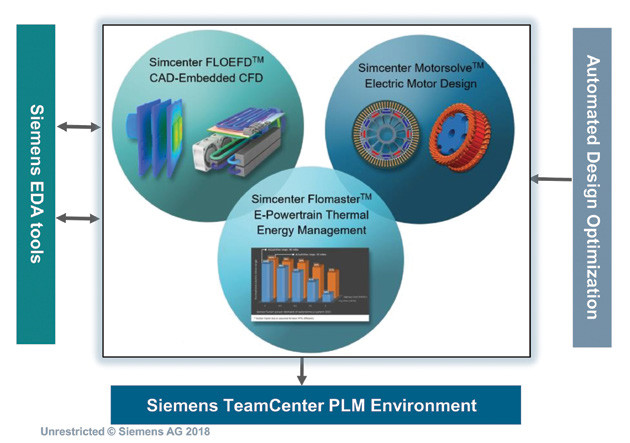 西门子PLM 的热管理模拟软件强调了维护数字主线的重要性。(图片来源:SIEMENS PLM)
西门子PLM 的热管理模拟软件强调了维护数字主线的重要性。(图片来源:SIEMENS PLM) 西门子专为自动驾驶汽车的热管理模拟推出了全新的Simcenter 解决方案。该方案用一种易于使用的格式,结合了公司现有的三个解决方案,实现了电气、电子和机械模拟的无缝联通。(图片来源:SIEMENS PLM)
西门子专为自动驾驶汽车的热管理模拟推出了全新的Simcenter 解决方案。该方案用一种易于使用的格式,结合了公司现有的三个解决方案,实现了电气、电子和机械模拟的无缝联通。(图片来源:SIEMENS PLM)
解决热管理挑战对自动驾驶汽车的发展至关重要。西门子 PLM 的全新 Simcenter 集成模拟包可为用户提供高度保真、简单易用的模拟解决方案。
解决热管理挑战对自动驾驶汽车的发展至关重要。西门子 PLM 的全新 Simcenter 集成模拟包可为用户提供高度保真、简单易用的模拟解决方案。
西门子 PLM 最近推出了一款新的 Simcenter 热管理软件模拟解决方案,专门用于自动驾驶电动汽车(AEV)开发,可以帮助工程师快速解决车辆在大功率电子设备热管理方面的挑战。
据了解,西门子在开发这款工具时专门优化了模拟速度和易用性。汽车制造商已经意识到,传统 CAE 模拟工具的确也可以满足需求,但将模拟技术限制在少数专家手里会导致项目进展缓慢且成本昂贵。对此,当务之急是寻找一套可供特定自动驾驶组件的设计与发布工程师使用的专门软件,也就是实现所谓的“CAE 技术民主化”。在此背景下,西门子 PLM 的软件模拟解决方案应运而生,也正是希望加速“CAE 技术民主化”的进程。
综合物理学
自动驾驶汽车均会配备传感器融合装置,耗电相当巨大,对热管理有很高需求。事实上,功率和热负载管理对内燃发动机也同样重要,但对电动汽车却可以说决定成败:电池组的温度不能太低,传感器和电子设备的温度不能太高。对于每一丁点电量都非常宝贵的电动汽车而言,对热功率进行有效管理可以发挥巨大作用。西门子称,如果不进行优化,光是车载电子元件耗电就会砍掉车辆 35% 的续航里程。
西门子的新型集成 CAE 解决方案套装集成了 Simcenter 的三种 CAE 模拟工具,分别为用于三维热传分析的 FLOEFD、用于电机设计的MotorSolve,及用于电传动系统热能管理的 Flomaster,达到了让这三种工具相互联通的目的。仅此一套工具不仅可以模拟组件的热动力系统和电传动系统性能,还能在“电机性能模拟”和“电气和热管理系统模拟”之间实现联通。
FloEFDCFD 是一款功能完整的三维流体流动和热传分析工具,可提供多孔介质、印刷电路板和 LED 等多种工程模型,还集成了电子元件冷却模块,可以对围绕热管理对电子元件进行精密建模。此外,该工具还可提供针对电动汽车电池的“电化学—热模拟”功能。据西门子称,目前,FloEFD CFD 工具已经集成至克里欧(Creo)、CATIA V5、Siemens NX、Solid Edge 等多个主流 MCAD 系统。
MotorSolve是一款专门的电机设计和分析软件,可以基于有限元分析、自动网格细化、后处理技术及储备领域知识,计算设计人员希望了解的设计参数,适用于无刷直流电机、感应电机、开关磁阻电机和有刷直流电机等。
Flomaster是一款一维求解器,适用于热流体等可以进行一维建模的系统。为了提高模拟精度,工程人员可以先使用之前提到的 FLOEFD 对单个组件进行三维建模,然后将这些模型导入 Flomaster 进行系统性的一维模拟。西门子 PLM 的 MAD 汽车经理 PuneetSinha 表示,“我们的一维和三维 CFD 解决方案是相互联通的。”
给工程师使用
Simcenter热管理软件模拟软件的预期用户是主流汽车工程师。Sinha 认为,新软件采用了模拟自动化、内置数据库和数据模型表示等手段,易用性大大提高。
Sinha 表示,“电气、电子和机械领域存在千丝万缕的联系。”这套软件首发时还会增加优化设计和创成设计的功能,且这些功能还会在后续发布中逐步增强。
Sinha 表示,这种组合套件特别适合为传动系统、处理器和传感器生成热管理模拟“数字模型”,而这些技术正是下一代自动驾驶汽车的关键使能技术。这样一来,西门子软件在自动驾驶汽车研发中可以发挥的作用不言而喻。未来,西门子将在这套工具的基础上继续推动“CAE 技术民主化”,也就是提供可以给非专家人士使用的 CAE 工具。这也意味着,未来,西门子 FLOEFD 用户在使用工具时不再需要了解各种 CFD 复杂参数,比如网格创建、层流或湍流模型的选择等。
Solving thermal challenges is vital to AEV development. Siemens PLM’s new Simcenter integrated simulation package offers a high-fidelity, easy-to-use solution.
Siemens PLM recently introduced a new Simcenter software solution for thermal simulation used in autonomous electric vehicle (AEV) development. The product is designed to help engineers quickly solve heat-related challenges related to the vehicles’ high- power electronics.
Speed and ease-of-use were important considerations in development of this tool. While traditional CAE simulations are useful, automakers are finding that restricting simulations to a few experts leads to a slow and costly engineering process. The answer is software that a design-and-release engineer devoted to specific AEV components can exercise. In general, this has come to be known as the “democratization of CAE,” and Siemens PLM hopes to accelerate this trend with the new offering.
Integrated physics
AEVs, with their power-hungry sensor fusion boxes, have significant thermal-management demands. While properly addressing these power and thermal loads is important even in combustion-engine automated vehicles, it is paramount in battery electrics. Keeping the battery pack not too cold, and the sensors and electronics not too hot, makes all the difference when every fraction of a kilowatt hour counts. The electronics alone, if not optimized, can reduce an AEV’s range by as much as 35%, according to Siemens.
The new integrated CAE solution package combines three of Simcenter’s CAE simulations: FLOEFD for 3-D thermal analysis; MotorSolve for electric motor design, and Flomaster, a 1-D CAE for electric powertrain thermal energy management. All three are now linked—for component thermal and electric powertrain performance, connectivity between simulation of electric motor performance and system simulation for electrical and thermal management.
FloEFD CFD is full-featured 3-D fluid flow and heat transfer analysis. It includes engineering models such as porous media, PCB and LED model. It is built into major MCAD systems such as Creo, CATIA V5, Siemens NX, Solid Edge, according to Siemens. It also includes an electronics cooling module for detailed thermal modeling of electronic models. Battery electrochemical-thermal simulation capabilities are available.
MotorSolve is Siemens’ design and analysis software for brushless DC, induction, switched reluctance and brushed DC machines. It is based on finite element analysis with automatic mesh refinement, post-processing and domain knowledge to compute design parameters that are of interest to a motor designer.
The third element, Flomaster, is a 1-D solver for thermo-fluid system or other simulations that can be captured in 1-D. For higher accuracy, individual components can be solved in 3-D using FLOEFD, and then summarized and connected in the 1-D Flomaster model. “The 1-D and 3-D CFD solutions are dynamically linked simulations,” said Puneet Sinha, MAD Automotive Manager at Siemens PLM.
In the hands of engineers
Just as important as the physics is the intended user: mainstream automotive engineers. Enhancing ease of use, according to Sinha, are simulation automation, a built-in database, and model representation from data.
“There is a seamless connection among electrical, electronics, and mechanical domains,” he said. There will also be some access to design optimization and generative design capabilities in this initial roll-out. He anticipates these features to be strengthened in future releases.
The combined package is especially useful for generating thermal “digital twin” simulations of the powertrain, processors, and sensors, according to Sinha. These and other key enabling technologies are anticipated to be used in next-generation AEV designs. This latest tool can be viewed as a further development in the “democratization of CAE” trend among CAE providers in the last few years. This movement views accessibility of CAE to non-specialists as the next, vital step in making CAE useful to industry. This also means that the user of Siemens’ FLOEFD software, in particular, will not need to know about some of the trickier aspects of CFD, such as mesh creation, selection of a laminar or turbulence flow model, or what type of turbulence model to apply.
Author: Bruce Morey
Source: Autonomous Vehicle Engineering
等级
打分
- 2分
- 4分
- 6分
- 8分
- 10分
平均分
